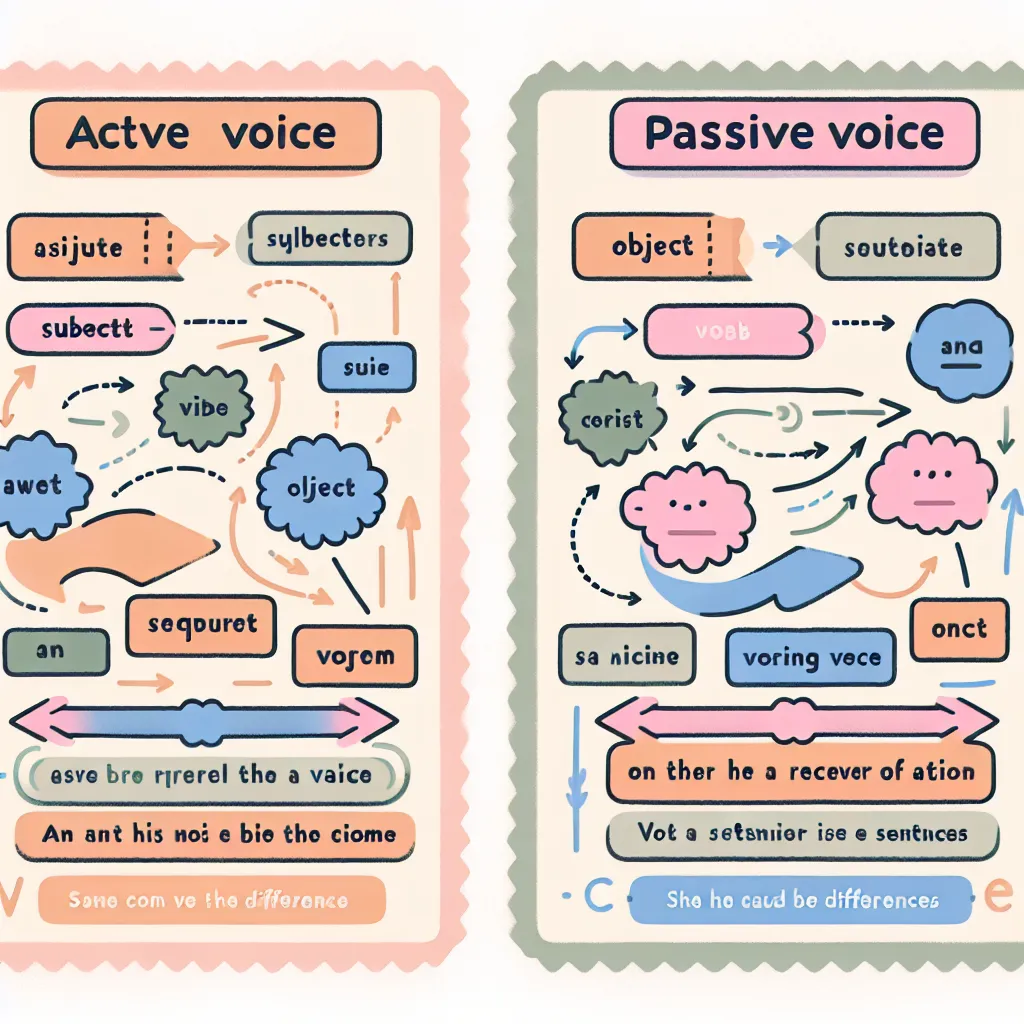Understanding the difference between active and passive voice is crucial for mastering English grammar and improving your writing skills. Whether you’re preparing for the IELTS exam or simply want to enhance your language proficiency, this guide will help you grasp the concept and use both voices effectively.
What are Active and Passive Voice?
Active and passive voice are two different ways of structuring sentences in English. The main difference lies in how the subject, verb, and object are arranged and which element is emphasized.
Active Voice
In active voice, the subject of the sentence performs the action. The structure is straightforward: Subject + Verb + Object.
Example: The cat (subject) chased (verb) the mouse (object).
Passive Voice
In passive voice, the subject receives the action. The structure is: Object + be + Past Participle + by + Subject.
Example: The mouse (object) was chased (be + past participle) by the cat (subject).
 Active vs Passive Voice
Active vs Passive Voice
Why is Understanding the Difference Important?
- Clarity: Active voice often creates clearer, more direct sentences.
- Emphasis: Passive voice can be used to emphasize the receiver of the action.
- Writing Style: Different writing styles may require different voices.
- IELTS Success: Proper use of both voices can improve your IELTS Writing and Speaking scores.
How to Learn the Difference
1. Identify the Subject and Object
The first step in distinguishing between active and passive voice is to identify the subject (doer of the action) and the object (receiver of the action) in a sentence.
Practice Exercise:
- Active: The chef (subject) prepared (verb) the meal (object).
- Passive: The meal (object) was prepared (verb) by the chef (subject).
2. Recognize the Verb Forms
Active voice uses simple verb tenses, while passive voice always includes a form of “to be” followed by the past participle.
Examples:
- Active: She writes (simple present) a letter.
- Passive: A letter is written (is + past participle) by her.
3. Study Sentence Transformations
Learn how to transform sentences from active to passive and vice versa. This skill is particularly useful for improving your English paraphrasing skills.
Exercise:
Transform these active sentences into passive:
- The student submitted the assignment.
- The company will launch a new product next month.
(Answers at the end of the article)
4. Practice with Real-world Examples
Use authentic materials like news articles, academic papers, or literature to identify and analyze the use of active and passive voice in context.
 Active and Passive Voice Practice
Active and Passive Voice Practice
5. Use Online Resources and Exercises
Utilize online grammar checkers and exercise websites to practice identifying and converting between active and passive voice. Websites like Grammarly or the British Council’s LearnEnglish site offer excellent resources.
Common Mistakes to Avoid
- Overusing Passive Voice: While passive voice has its place, overuse can make your writing unclear or tedious.
- Incomplete Passive Constructions: Ensure you include the “by + subject” phrase when necessary for clarity.
- Confusing Past Tense with Passive Voice: Remember, not all sentences with past participles are passive.
Tips for Mastering Active and Passive Voice
- Read Extensively: Exposure to various writing styles will help you understand when and how each voice is used.
- Practice Writing: Incorporate both voices in your English writing practice.
- Seek Feedback: Have a teacher or language exchange partner review your use of active and passive voice.
- Use Context: Understand that the choice between active and passive often depends on the context and purpose of your writing.
When to Use Each Voice
Active Voice
- For clear, direct communication
- When the doer of the action is important or known
- In most everyday conversations and informal writing
Passive Voice
- When the receiver of the action is more important than the doer
- In scientific or academic writing to maintain an objective tone
- When the doer of the action is unknown or irrelevant
Next Steps
Now that you understand the basics of active and passive voice, it’s time to put your knowledge into practice. Here are some suggested activities:
- Analyze a news article, identifying all instances of active and passive voice.
- Write a short paragraph about your daily routine, then rewrite it changing all active sentences to passive and vice versa.
- Take an online quiz to test your ability to distinguish between the two voices.
Remember, mastering the difference between active and passive voice takes time and practice. Be patient with yourself and celebrate your progress along the way. If you’re preparing for the IELTS exam, consider how to improve your grammar when writing emails, as this skill is valuable for the Writing section.
By consistently applying these techniques and practicing regularly, you’ll soon find yourself confidently navigating the nuances of active and passive voice in English. Keep exploring, keep practicing, and watch your language skills soar!
(Answers to the transformation exercise:
- The assignment was submitted by the student.
- A new product will be launched by the company next month.)




